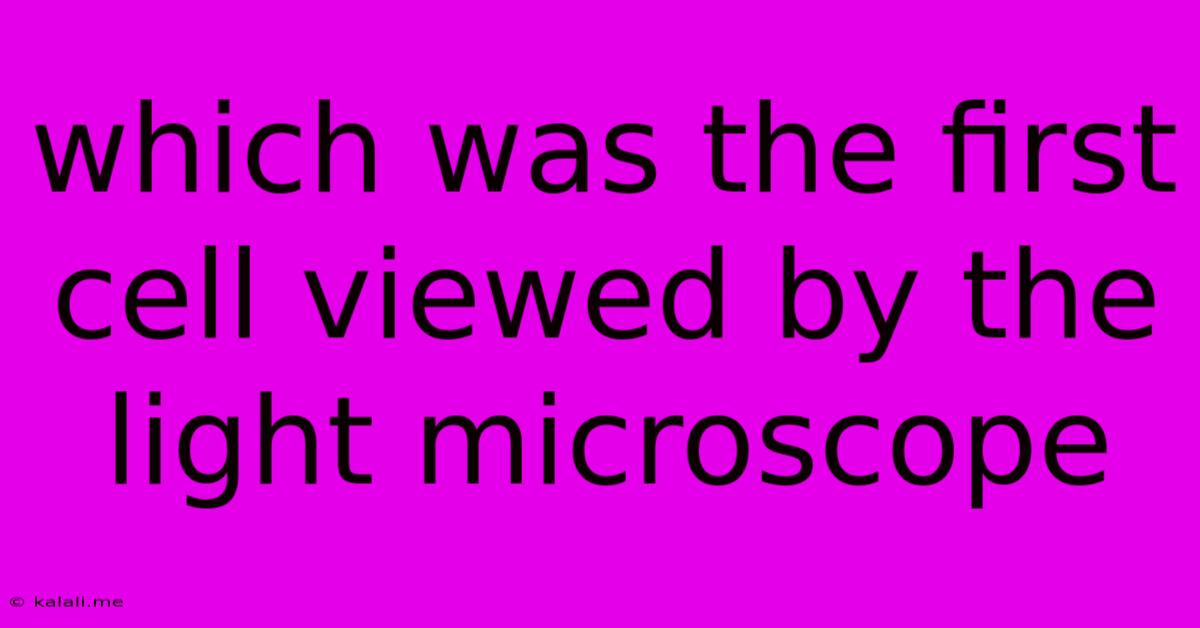Which Was The First Cell Viewed By The Light Microscope
Kalali
May 10, 2025 · 3 min read

Table of Contents
Which Was the First Cell Viewed by the Light Microscope? A Look into Microscopic History
The question of which cell was first viewed under a light microscope is a fascinating one, steeped in the history of scientific discovery. While pinpointing the very first cell is impossible due to limitations in early microscopy and record-keeping, we can confidently discuss the pivotal observations that led to the cell theory. This article explores the early history of microscopy and the crucial role of Robert Hooke's observations in shaping our understanding of cells. We'll also examine the limitations of early microscopes and the subsequent advancements that truly revealed the complexity of cellular life.
Robert Hooke and the Birth of "Cell":
In 1665, Robert Hooke, using a self-designed compound microscope, observed thin slices of cork. He noted tiny, box-like compartments which he named "cells" due to their resemblance to the small rooms occupied by monks in a monastery. This is widely considered the first observation of cells, though it's important to note that he was observing the dead cell walls of plant tissue, not living cells. Hooke's detailed illustrations in his book Micrographia brought these structures to the attention of the scientific community, sparking further interest in microscopic investigation.
Limitations of Early Microscopes:
Hooke's microscope, while groundbreaking for its time, had significant limitations. The resolution was relatively low, meaning it couldn't reveal the intricate details of living cells. The magnification was also limited, preventing clear observation of internal cellular structures like the nucleus or organelles. It was difficult to prepare suitable samples for observation, and the lack of sophisticated staining techniques further hampered the process. Consequently, Hooke's observations primarily focused on the structural outlines of what he termed “cells.”
Beyond Hooke: Antonie van Leeuwenhoek and the Discovery of Microorganisms:
While Hooke observed cell walls, Antonie van Leeuwenhoek's work significantly advanced our understanding of microscopic life. Using his single-lens microscopes, which offered superior magnification to Hooke's compound microscope, he observed various microorganisms in pond water, including bacteria and protozoa. These were undoubtedly living cells, though the detailed internal structures remained largely unseen. Leeuwenhoek’s meticulous observations and detailed drawings contributed greatly to the growing body of knowledge about microscopic life. His descriptions of “animalcules” significantly expanded the understanding of the vast diversity of microscopic organisms.
The Development of Cell Theory:
The observations of Hooke and Leeuwenhoek, along with the contributions of many other scientists over the following centuries, led to the formulation of the cell theory. This cornerstone of biology states that:
- All living organisms are composed of one or more cells.
- The cell is the basic unit of structure and organization in organisms.
- Cells arise from pre-existing cells.
This theory emerged gradually, with improvements in microscopy and staining techniques allowing scientists to visualize cellular components with ever-increasing clarity. The discovery of the nucleus and other organelles further refined our understanding of cell structure and function.
In Conclusion:
While Robert Hooke's observation of cork cells in 1665 is generally considered the first description of cells viewed under a light microscope, it's crucial to understand the context. He observed dead cell walls, not living cells with their internal complexities. Antonie van Leeuwenhoek’s observations of living microorganisms significantly expanded our understanding of microscopic life. The development of the cell theory was a collaborative effort building upon centuries of increasingly refined microscopic observations and technological advancements. Therefore, the answer isn't simply about the first cell, but rather the culmination of early microscopic discoveries that fundamentally changed our understanding of life itself.
Latest Posts
Latest Posts
-
40 Oz Of Water Is How Many Cups
Jul 18, 2025
-
How Many Eighths In A Quarter Pound
Jul 18, 2025
-
Can The Sine Of An Angle Ever Equal 2
Jul 18, 2025
-
How Many Months Is A Hundred Days
Jul 18, 2025
-
Mother And I Or Mother And Me
Jul 18, 2025
Related Post
Thank you for visiting our website which covers about Which Was The First Cell Viewed By The Light Microscope . We hope the information provided has been useful to you. Feel free to contact us if you have any questions or need further assistance. See you next time and don't miss to bookmark.